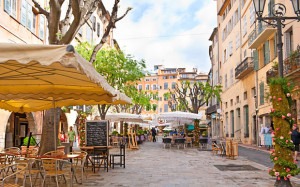Grasse Jasmine Festival
A young woman with cheeks painted Aunt Sally red throws a garland of white flowers towards me. I stretch up and catch it. Large silk petals frame the woman’s glowing face. She looks just like a flower. She’s just one of the smiling flower queens aboard a carnival float festooned with blossoms and posies. As float after float – all as colourful as fireworks – pass by, I can’t help but join in with the cheers coming from the exuberant crowd.
I’m watching the main parade of the annual Jasmine Festival held in Grasse, a small Provençal town tucked away in the hilltops of the French Riviera.
 Jasmine may be a small flower but the power of its heavenly scent – as well as the exquisite fragrances of other blooms grown here, including roses, mimosa, lavender and orange blossom – has attracted the world’s best perfume houses and “noses”, creating a thriving perfume industry that has provided thousands of jobs for the region. And every summer, for three sweet perfumed days, Grasse pays homage in extravagant style to the flower that has shaped the town’s destiny for centuries.
Jasmine may be a small flower but the power of its heavenly scent – as well as the exquisite fragrances of other blooms grown here, including roses, mimosa, lavender and orange blossom – has attracted the world’s best perfume houses and “noses”, creating a thriving perfume industry that has provided thousands of jobs for the region. And every summer, for three sweet perfumed days, Grasse pays homage in extravagant style to the flower that has shaped the town’s destiny for centuries.
Wandering through the Old Town, I see men in bowler hats wobble on stilts and women dressed up like hothouse blooms play jazzy numbers on golden trumpets. Beneath them, the cobbled streets are strewn with petals. Tall, pale orange townhouses are decorated with showy flower garlands. The bells of the town’s 12th-century cathedral ring out joyfully. On squares lined with cafes, children watch flower-themed puppet shows.
Did you know?
All of the jasmine and May roses that go into Chanel No 5 are grown in protected fields around Grasse. Chanel doesn’t use flowers grown anywhere else.
I take a break from the wafting swoony scents and head for Grasse’s International Perfume Museum, once an 18th-century mansion. Inside I find an amazing collection of perfume-related artifacts and paraphernalia from all corners of the globe spanning three millennia. I marvel at rare phials holding fragrances adored by the ancient Egyptians and exotic and beautifully embellished pomanders used by European aristocracy.
It’s here that I learn more about Grasse’s perfumed past. During the Middle Ages the town produced high-quality but unpleasant smelling leather goods, especially gloves. To mask the aroma, local flower essences were applied and scented gloves became all the rage. Grasse prospered as a result. New taxes, however, caused the leather industry to decline.
The perfumeries creating the scents were unaffected and continued to flourish. By the 1700s, more flowers than ever were being grown in the fields. Ever more prestigious perfume houses flocked to the town, concocting scents so sublime that Grasse soon became known as the perfume capital of the world.
Today, fewer perfume houses are based in Grasse. I visit Molinard’s, a French perfumery established in 1849. A tour takes me around the distillery and the collections of Baccarat crystal and Lalique glass. The highlight is a perfume-making session where I create my own scent from an array of aromatic herb and flower oils. I’m pleased with the result. It’s uplifting and, like my memories of Grasse, lingers on.

Comments are closed.